the Crown of the Continent

The Crown of the Continent
Waterton-Glacier National Park, International Peace Park World Heritage Site
“Far away in Northwestern Montana hidden from view by clustering mountain peaks, lies an unmapped corner, the Crown of the Continent” George Grinnell, 1901

“In a world beset by conflict and division, peace is one of the cornerstones of the future. Peace parks are a building block in this process not only in our region, but the potentiality in the entire world” Nelson Mandela

“When we try to pick out anything by itself, we find it hitched to everything else in the universe” John Muir 1890
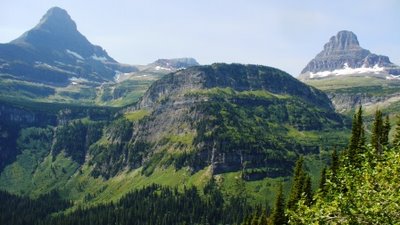
“Few places in the world are more dangerous than home. Fear not, therefore, to try the mountains passes. They kill care, save you from clearly apathy, and call for the every faculty into vigorous, enthusiastic action” John Muir

Heading west out of Shelby, out on Rt.2W into Glacier County, the landscape of oil and gas refineries, fresh cut wheat, now time to plant winter wheat after a dry summer here, into Cut Bank, the sign says millions of barrels of oil, billions barrels of gas, looking into the horizon, the mountains loom, I can see them in the distance drawing me in, pass Camp Disappointment, Lewis & Clark stayed here, says “Lewis: "…adieu to this place which I now call camp disappointment…"
the landscape of oil and gas refineries, fresh cut wheat, now time to plant winter wheat after a dry summer here, into Cut Bank, the sign says millions of barrels of oil, billions barrels of gas, looking into the horizon, the mountains loom, I can see them in the distance drawing me in, pass Camp Disappointment, Lewis & Clark stayed here, says “Lewis: "…adieu to this place which I now call camp disappointment…"
History: On July 22, 1806, Lewis halted his northward exploration of the Marias River here. It was not the natural boundary for the Louisiana Purchase he had hoped for. He had also hoped to find an easy portage route between the Marias and Saskatchewan rivers. Such a route would have allowed America to divert Canadian fur trade into American territory at the Missouri River. It was not to be. Dreary weather and gloomy prospects gave this camp its name.
Lewis and three companions, George Drouillard and the Field brothers, Joseph and Reubin camped here for three days before beginning their return to the Missouri. It was a risky stay as they were deep in the land of the Blackfeet. In fact, the next day, they encountered eight Blackfeet warriors and shared a camp with them. Unfortunately, Lewis also shared the fact that Americans would trade with all the tribes in coming years, including enemies of the Blackfeet. The Blackfoot Confederacy was the most powerful coalition in Montana at the time. The prospect of American rifles in the hands of their enemies threatened their dominance of the area and their existence.
Early the next morning, Lewis woke to the sounds of struggle. The warriors and expedition members fought for possession of the Corps' rifles and horses. Two of the warriors were killed in the only fatal encounter of the expedition.
Lewis compounded the gravity of the situation:
"While the men were preparing the horses I put four shields and two bows and quivers of arrows…on the fire, with sundry other articles…I also retook the flag but left the medal about the neck of the dead man, that they might be informed who we were."
The other Blackfeet survived to return to their tribe, and it is thought that this encounter had lasting consequences. George Drouillard, present at this fight, was one of three expedition members to return west after the expedition only to die in later conflicts with the Blackfeet.
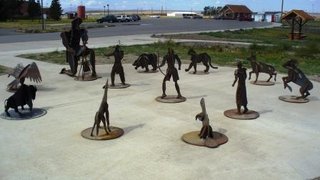 After leaving Cut Bank you are in the Blackfeet Reservation, wondering what they think about all the Lewis & Clark hoopla, into Browning to the Museum of the Plains Indian, displays of richly varied arts of the Northern Plains tribal peoples including the Blackfeet, Crow, northern Cheyenne, Sioux, Assinboine, Arapaho, Shoshone, Nez Pierce, Flathead, Chippewa and Cree, their historic clothing. horse gear, weapons, household goods highlight the exhibits, founded in 1941, it’s an excellent look at the lives of this nation of survivors, there are appoximattly 106,000 descendents on 16 reservations of Plains Indians.
After leaving Cut Bank you are in the Blackfeet Reservation, wondering what they think about all the Lewis & Clark hoopla, into Browning to the Museum of the Plains Indian, displays of richly varied arts of the Northern Plains tribal peoples including the Blackfeet, Crow, northern Cheyenne, Sioux, Assinboine, Arapaho, Shoshone, Nez Pierce, Flathead, Chippewa and Cree, their historic clothing. horse gear, weapons, household goods highlight the exhibits, founded in 1941, it’s an excellent look at the lives of this nation of survivors, there are appoximattly 106,000 descendents on 16 reservations of Plains Indians.
I meet a Native artist, not thinking about spending money, his art work was so symbolic of the my experience in the Museum, that I purchased one of his paintings, Ernest Marceau Jr. a big man, gentle, lively and encaging, he reminded me of the Gary Farmer from Pow Wow Highway, an excellent movie of Native experience, a must see, Gary Farmer was the founder and Publisher of Aboriginal Voices Magazine, a magazine which was devoted to Native Canadian issues.
On to the park, wild fires, started in late July, speculation the Boy Scout started it, 30% of the timber resources for the Blackfeet were lost. The fire is still burning, and in other areas of the West. The haze gives a blue tint to the landscape.
started in late July, speculation the Boy Scout started it, 30% of the timber resources for the Blackfeet were lost. The fire is still burning, and in other areas of the West. The haze gives a blue tint to the landscape.
Into the park taking Rt.49 on the southeastern corner working upward, witnessing the wildfire first hand, chars of tall trees, the smell of a day old campfire that has gotten wet, yet still along the roadside, white butterflies, thousands working their magic, then up the road, the views are shock and awe, magnificent land here, on to the St. Mary entrance on the East side, they have exhibits of Native artist works, all work about the Lewis and Clark experience, none too flattering, great to see, some artists to follow-up on: Corwin Clairmont, Damian Charette, Janeese Hilton and Ramon Murillo, one piece had these words, “When you had such a good guide, why is it that all I wanted is for you to get lost, get lost, get lost” by Gail Tremblay. As moving as the mountain these people once roamed, and have different names for then now.
Up to Many Glaciers, a great place to camp if you can get in, this fantastic valley with views 360, some they stay at the Hotel here, I am leaving to get a site at Rising Sun,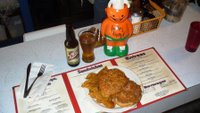
I stop at Two Sisters Café for a good Pulled Pork Sandwich, and great pies, Huckleberry, brave and bold.
Back to camp, where I meet Joe from Portland, a bus driver, Ralph Kramden would be proud, here, the most Oregon tags I have seen in a long time, I am in the West again, we talked about how to stay centered in this world today, he is going to Burning Man, I could make it, not this year, Oregonman Must Go Next Year, my pledge to the Cosmos. He owed me a book "This is Burning Man", I have started to read it, I have heard about this event, I shy away when things when they get popular, kinda like tattoos and piercing. Another great roadside conversation, have fun at Burning Man Joe!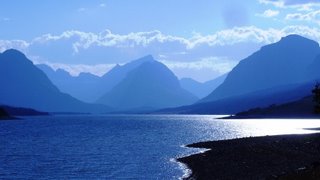
Up over Logan Pass to camp at Sprague Lake, tents only, full, than back to Avalanche Creek, under a grand old cedar tree I be, I be. Skate is a mountaineer, up and down, holding his own with anyone, especially now there he is using Premium, he’s a monster.
I will not say much of the views the pictures should speak for themselves.
The Glaciers are shrinking, in 1850 there where 150, now 27, in 25 years, None will exist, also the Alpine habitat is changing. Dick you could have had your energy summit here, great views.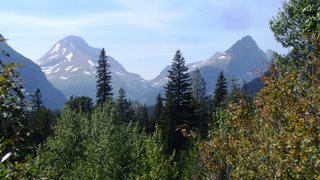
Another great place to eat on the Eastside is The Park Café, here since 1981, where pies are king, they have shakes too. On the Westside its Eddies, where I meet Eddie the Grizzly Bear, nice fellow, likes beer like me. At Eddies I read that Charlie Russell, the great Western painter and humorist worked and lived here.
Russell said” Two guides went out one morning to round up their horses and in crossing a strip of woodland, they meet a belligerent moose who made it necessary for them to seek cover with no delay. One of the guides slid into a convenient hole and the other climbed a tree while the moose just waited around. After a time, the man in the hole stuck out his head and asked “has he gone yet?”, and the man in the tree said “No”, after a few minutes, he raised up and asked again” hasn’t he gone yet?’. The man in the tree replied, in not too refined language, “No!! and he never go if you keep popping out of that hole”
“Well”, said the other fellow, “There is a bear in this hole”.

Campfire under the cedar trees, sky full of starts, no moon, hooting of an owl in a distant tree, the still night air, releasing the smell of the forest, sipping whiskey, finishing The Appalachians, a great book, about its people, culture, stories, songs and life, a place changed and unchanged, exploited and hidden, with knowledge of the forest path and its treasures, a story of greed and damage done, a story of hope, a story of history, its roots to our tribe, over water in a distant land, our voices the same.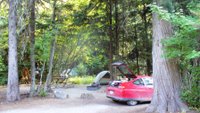
At camp I meet an Australian man Ian, bought a motorbike to see the West and is riding this 650cc motorbike out of Seattle heading out into the mountains, then heading south to Utah, another great conversation around the fire, talks of our homes, politics, he says that their government wants to be a player in the big picture, yet is behind few years, tell George they are Willin’, Most folks want to smae thing, his people is like ours, they just want to have a Roasted Lamb on Sundays with family, and they Don’t drink Fosters, good, I never liked it anyway, people all around the world want the same thing, logical and responsible governments, of the people, for the people.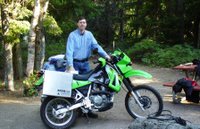
Drinking Sky Diver Blonde out of Marion, Montana, and Bayern St. Wilbur Weizen out of Missoula and some Knob Creek, wanted a sip for awhile, been looking at a bottle since I have been in the North Country
Next morning cool, said goodbye to Ian, broke camp. Westward!
Reading Rumi, “What color cloth you want, let the boy Jesus pull it out of the big dark dyeing vat”, Coleman Bark’s asking his son, “What is all this longing”?
His son left his Dad a note the next morning, “Maybe it’s because nobody has any brakes, We can’t stop. Whoooooooeeee”!
Shelby to Rising Sun
62.5 mpg/ 166.7 miles traveled
Rising Sun to Avalanche, and over Logan Pass
68.1 mpg/ 112.7 miles traveled
Avalanche to Logan’s Pass and back
63.9 mpg/ 81.6 miles traveled
Waterton-Glacier National Park, International Peace Park World Heritage Site
“Far away in Northwestern Montana hidden from view by clustering mountain peaks, lies an unmapped corner, the Crown of the Continent” George Grinnell, 1901

“In a world beset by conflict and division, peace is one of the cornerstones of the future. Peace parks are a building block in this process not only in our region, but the potentiality in the entire world” Nelson Mandela

“When we try to pick out anything by itself, we find it hitched to everything else in the universe” John Muir 1890

“Few places in the world are more dangerous than home. Fear not, therefore, to try the mountains passes. They kill care, save you from clearly apathy, and call for the every faculty into vigorous, enthusiastic action” John Muir

Heading west out of Shelby, out on Rt.2W into Glacier County,
 the landscape of oil and gas refineries, fresh cut wheat, now time to plant winter wheat after a dry summer here, into Cut Bank, the sign says millions of barrels of oil, billions barrels of gas, looking into the horizon, the mountains loom, I can see them in the distance drawing me in, pass Camp Disappointment, Lewis & Clark stayed here, says “Lewis: "…adieu to this place which I now call camp disappointment…"
the landscape of oil and gas refineries, fresh cut wheat, now time to plant winter wheat after a dry summer here, into Cut Bank, the sign says millions of barrels of oil, billions barrels of gas, looking into the horizon, the mountains loom, I can see them in the distance drawing me in, pass Camp Disappointment, Lewis & Clark stayed here, says “Lewis: "…adieu to this place which I now call camp disappointment…"History: On July 22, 1806, Lewis halted his northward exploration of the Marias River here. It was not the natural boundary for the Louisiana Purchase he had hoped for. He had also hoped to find an easy portage route between the Marias and Saskatchewan rivers. Such a route would have allowed America to divert Canadian fur trade into American territory at the Missouri River. It was not to be. Dreary weather and gloomy prospects gave this camp its name.
Lewis and three companions, George Drouillard and the Field brothers, Joseph and Reubin camped here for three days before beginning their return to the Missouri. It was a risky stay as they were deep in the land of the Blackfeet. In fact, the next day, they encountered eight Blackfeet warriors and shared a camp with them. Unfortunately, Lewis also shared the fact that Americans would trade with all the tribes in coming years, including enemies of the Blackfeet. The Blackfoot Confederacy was the most powerful coalition in Montana at the time. The prospect of American rifles in the hands of their enemies threatened their dominance of the area and their existence.
Early the next morning, Lewis woke to the sounds of struggle. The warriors and expedition members fought for possession of the Corps' rifles and horses. Two of the warriors were killed in the only fatal encounter of the expedition.
Lewis compounded the gravity of the situation:
"While the men were preparing the horses I put four shields and two bows and quivers of arrows…on the fire, with sundry other articles…I also retook the flag but left the medal about the neck of the dead man, that they might be informed who we were."
The other Blackfeet survived to return to their tribe, and it is thought that this encounter had lasting consequences. George Drouillard, present at this fight, was one of three expedition members to return west after the expedition only to die in later conflicts with the Blackfeet.
 After leaving Cut Bank you are in the Blackfeet Reservation, wondering what they think about all the Lewis & Clark hoopla, into Browning to the Museum of the Plains Indian, displays of richly varied arts of the Northern Plains tribal peoples including the Blackfeet, Crow, northern Cheyenne, Sioux, Assinboine, Arapaho, Shoshone, Nez Pierce, Flathead, Chippewa and Cree, their historic clothing. horse gear, weapons, household goods highlight the exhibits, founded in 1941, it’s an excellent look at the lives of this nation of survivors, there are appoximattly 106,000 descendents on 16 reservations of Plains Indians.
After leaving Cut Bank you are in the Blackfeet Reservation, wondering what they think about all the Lewis & Clark hoopla, into Browning to the Museum of the Plains Indian, displays of richly varied arts of the Northern Plains tribal peoples including the Blackfeet, Crow, northern Cheyenne, Sioux, Assinboine, Arapaho, Shoshone, Nez Pierce, Flathead, Chippewa and Cree, their historic clothing. horse gear, weapons, household goods highlight the exhibits, founded in 1941, it’s an excellent look at the lives of this nation of survivors, there are appoximattly 106,000 descendents on 16 reservations of Plains Indians.I meet a Native artist, not thinking about spending money, his art work was so symbolic of the my experience in the Museum, that I purchased one of his paintings, Ernest Marceau Jr. a big man, gentle, lively and encaging, he reminded me of the Gary Farmer from Pow Wow Highway, an excellent movie of Native experience, a must see, Gary Farmer was the founder and Publisher of Aboriginal Voices Magazine, a magazine which was devoted to Native Canadian issues.

On to the park, wild fires,
 started in late July, speculation the Boy Scout started it, 30% of the timber resources for the Blackfeet were lost. The fire is still burning, and in other areas of the West. The haze gives a blue tint to the landscape.
started in late July, speculation the Boy Scout started it, 30% of the timber resources for the Blackfeet were lost. The fire is still burning, and in other areas of the West. The haze gives a blue tint to the landscape.Into the park taking Rt.49 on the southeastern corner working upward, witnessing the wildfire first hand, chars of tall trees, the smell of a day old campfire that has gotten wet, yet still along the roadside, white butterflies, thousands working their magic, then up the road, the views are shock and awe, magnificent land here, on to the St. Mary entrance on the East side, they have exhibits of Native artist works, all work about the Lewis and Clark experience, none too flattering, great to see, some artists to follow-up on: Corwin Clairmont, Damian Charette, Janeese Hilton and Ramon Murillo, one piece had these words, “When you had such a good guide, why is it that all I wanted is for you to get lost, get lost, get lost” by Gail Tremblay. As moving as the mountain these people once roamed, and have different names for then now.
Up to Many Glaciers, a great place to camp if you can get in, this fantastic valley with views 360, some they stay at the Hotel here, I am leaving to get a site at Rising Sun,

I stop at Two Sisters Café for a good Pulled Pork Sandwich, and great pies, Huckleberry, brave and bold.

Back to camp, where I meet Joe from Portland, a bus driver, Ralph Kramden would be proud, here, the most Oregon tags I have seen in a long time, I am in the West again, we talked about how to stay centered in this world today, he is going to Burning Man, I could make it, not this year, Oregonman Must Go Next Year, my pledge to the Cosmos. He owed me a book "This is Burning Man", I have started to read it, I have heard about this event, I shy away when things when they get popular, kinda like tattoos and piercing. Another great roadside conversation, have fun at Burning Man Joe!

Up over Logan Pass to camp at Sprague Lake, tents only, full, than back to Avalanche Creek, under a grand old cedar tree I be, I be. Skate is a mountaineer, up and down, holding his own with anyone, especially now there he is using Premium, he’s a monster.

I will not say much of the views the pictures should speak for themselves.
The Glaciers are shrinking, in 1850 there where 150, now 27, in 25 years, None will exist, also the Alpine habitat is changing. Dick you could have had your energy summit here, great views.

Another great place to eat on the Eastside is The Park Café, here since 1981, where pies are king, they have shakes too. On the Westside its Eddies, where I meet Eddie the Grizzly Bear, nice fellow, likes beer like me. At Eddies I read that Charlie Russell, the great Western painter and humorist worked and lived here.
Russell said” Two guides went out one morning to round up their horses and in crossing a strip of woodland, they meet a belligerent moose who made it necessary for them to seek cover with no delay. One of the guides slid into a convenient hole and the other climbed a tree while the moose just waited around. After a time, the man in the hole stuck out his head and asked “has he gone yet?”, and the man in the tree said “No”, after a few minutes, he raised up and asked again” hasn’t he gone yet?’. The man in the tree replied, in not too refined language, “No!! and he never go if you keep popping out of that hole”
“Well”, said the other fellow, “There is a bear in this hole”.

Campfire under the cedar trees, sky full of starts, no moon, hooting of an owl in a distant tree, the still night air, releasing the smell of the forest, sipping whiskey, finishing The Appalachians, a great book, about its people, culture, stories, songs and life, a place changed and unchanged, exploited and hidden, with knowledge of the forest path and its treasures, a story of greed and damage done, a story of hope, a story of history, its roots to our tribe, over water in a distant land, our voices the same.

At camp I meet an Australian man Ian, bought a motorbike to see the West and is riding this 650cc motorbike out of Seattle heading out into the mountains, then heading south to Utah, another great conversation around the fire, talks of our homes, politics, he says that their government wants to be a player in the big picture, yet is behind few years, tell George they are Willin’, Most folks want to smae thing, his people is like ours, they just want to have a Roasted Lamb on Sundays with family, and they Don’t drink Fosters, good, I never liked it anyway, people all around the world want the same thing, logical and responsible governments, of the people, for the people.

Drinking Sky Diver Blonde out of Marion, Montana, and Bayern St. Wilbur Weizen out of Missoula and some Knob Creek, wanted a sip for awhile, been looking at a bottle since I have been in the North Country
Next morning cool, said goodbye to Ian, broke camp. Westward!
Reading Rumi, “What color cloth you want, let the boy Jesus pull it out of the big dark dyeing vat”, Coleman Bark’s asking his son, “What is all this longing”?
His son left his Dad a note the next morning, “Maybe it’s because nobody has any brakes, We can’t stop. Whoooooooeeee”!
Shelby to Rising Sun
62.5 mpg/ 166.7 miles traveled
Rising Sun to Avalanche, and over Logan Pass
68.1 mpg/ 112.7 miles traveled
Avalanche to Logan’s Pass and back
63.9 mpg/ 81.6 miles traveled


0 Comments:
Post a Comment
<< Home